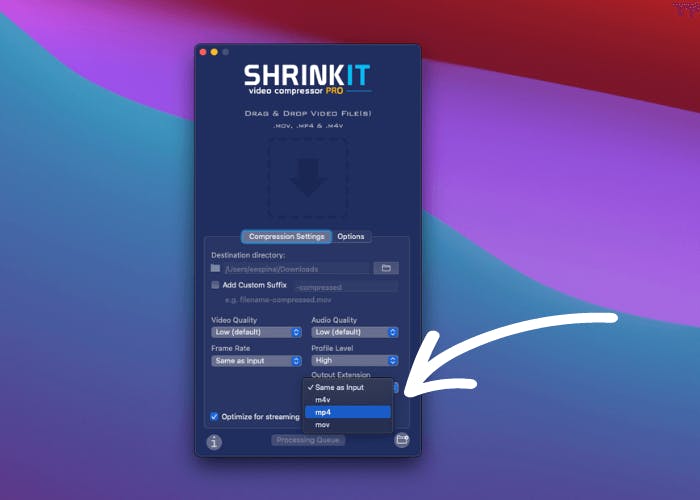MP4 vs MOV: Understanding the Key Differences in Video Formats
Dive into the essential differences between MP4 and MOV video formats to help content creators make informed decisions for their projects.
Posted by
Related reading
How to Convert Videos for Twitter to Maximize Engagement
Learn how to optimize and convert videos for Twitter to enhance visibility and boost engagement with specific steps and recommended tools.
Compressing Videos for Social Media: Tips and Best Practices
Optimize videos for social media with efficient compression techniques and top tools like Adobe Media Encoder and ShrinkIt for high-quality, compact files.
Understanding Video Compression
Explore the essentials of video compression: what it is, why it's important, and the difference between lossy and lossless compression.

Introduction to MP4 and MOV Video Formats
Let's take a quick trip down memory lane. MP4, or MPEG-4 Part 14, was developed by the Moving Picture Experts Group (MPEG) in 2001. It quickly became a go-to format for its versatility and compatibility across various platforms. On the other hand, MOV, or QuickTime File Format, was created by Apple in 1991 and has been a staple in the Apple ecosystem ever since.
As a content creator, understanding the pros and cons of MP4 vs MOV is essential. It can save you time, headaches, and even improve the quality of your final product. Whether you're creating videos for YouTube, social media, or professional projects, knowing which format to use can make all the difference.
Key Characteristics of MP4 Format
Now, let's dive into the nitty-gritty of MP4. This format uses the MPEG-4 video compression standard, which offers excellent video quality while keeping file sizes relatively small. It's like having your cake and eating it too! MP4 files are widely supported across various devices and platforms, making them a popular choice for content creators.
Advantages of using MP4
- Excellent compatibility with most devices and platforms
- Efficient video compression, resulting in smaller file sizes
- Supports a wide range of video codecs and audio formats
- Ideal for streaming and online video sharing
Limitations of MP4 format
- Limited support for professional-grade video editing features
- May experience quality loss when compressed heavily
Key Characteristics of MOV Format
Now, let's talk about MOV. This format, developed by Apple, uses the QuickTime video codec. MOV files are known for their high video quality and are often used in professional video production settings. However, they tend to have larger file sizes compared to MP4.
Advantages of using MOV
- Retains high video quality, making it suitable for professional projects
- Supports a wide range of video codecs and audio formats
- Ideal for video editing within the Apple ecosystem
Limitations of MOV format
- Limited compatibility with non-Apple devices and platforms
- Larger file sizes compared to MP4
- May require conversion for wider accessibility
Comparing MP4 and MOV: Which is Better?
When it comes to choosing between MP4 vs MOV, it's essential to consider factors like file size, video quality, and compatibility. Let's take a closer look at how these two video formats stack up against each other.
File size and compression
One of the primary differences between MP4 and MOV is their file size. MP4 files are generally smaller due to their efficient video compression techniques. This makes them ideal for sharing online or sending via email, as they take up less storage space and upload faster.
Video quality and resolution
While MP4 offers excellent video quality, MOV files are often favored by professionals for their ability to retain higher quality and resolution. If you're working on a project that demands the best possible video quality, MOV might be the way to go.
Compatibility across devices and platforms
When it comes to compatibility, MP4 has the upper hand. It's widely supported across various devices and platforms, making it easier to share your videos with a broader audience. MOV files, on the other hand, are best suited for the Apple ecosystem.
Suitability for specific use cases
Depending on your specific needs, either MP4 or MOV might be the better choice. For web and mobile use, MP4 is often preferred due to its smaller file size and broad compatibility. However, if you're working on a professional video editing project within the Apple ecosystem, MOV can be a great choice.
Converting Between MP4 and MOV Formats
Sometimes, you may need to convert your videos from one format to another. Whether you're looking to share your MOV files with a wider audience or reduce the file size of your MP4 videos for easier storage and sharing, converting between these two video formats is a common task.
Why convert video formats
Converting video formats can help you:
- Ensure compatibility with specific devices or platforms
- Reduce file sizes for easier sharing and storage
- Maintain video quality while changing formats
Best tools for converting MP4 to MOV and vice versa
There are several tools available for converting between MP4 and MOV formats. Some popular options include:
Quality Reduction When Uploading Videos to Social Media
Creators can run into challenges when posting their edited videos to social media. In a Reddit post on r/videography, one user complained about poor quality when uploading videos to Instagram Reels:
"I'm not hoping for 4k videos, but man does it look like 360p compared to the 1080p file that I'm uploading from my phone. The irritating thing is, when it's first posted it looks great on the first playthrough, but as soon as it's viewed from any other device or is viewed from my page, the videos instantly have a nasty noise/compression."
Despite shooting high quality video on a Blackmagic Pocket Cinema Camera 6K Pro, the user found their videos were heavily compressed after uploading. They tried various workarounds like limiting bitrate, resizing to different aspect ratios, sharpening in post, and uploading from different devices and apps. But the quality issues persisted.
Another Redditor noted similar problems with quality reduction when uploading images created in Photoshop to Instagram. The images looked fine on their laptop and phone, but the quality was severely lowered after posting to Instagram, even with a good internet connection.
The takeaway is that video and image compression used by social media apps can significantly degrade quality compared to the original files, regardless of the recording/editing device. Experimenting with different export settings, bitrates, and uploading methods may improve results, but the level of improvement will vary. Keep this in mind and manage expectations when publishing visual content to social platforms.
Introducing ShrinkIt: An Easy-to-Use Video Compression Tool
As a content creator who has tried countless video compression tools, I can confidently say that ShrinkIt is a game-changer. This powerful app simplifies the process of compressing and converting video files, making it an essential tool for anyone working with MP4 vs MOV formats.
Key features of ShrinkIt
- Fast and efficient video compression
- Intuitive drag-and-drop interface
- Unique comparison tool for previewing original and compressed videos
- Superior performance compared to other popular video compression tools
How ShrinkIt simplifies video format conversion
ShrinkIt takes the hassle out of converting between MP4 and MOV formats. With just a few clicks, you can compress and convert your videos, ensuring compatibility and optimal file sizes for your specific needs.

Benefits for content creators using ShrinkIt
By using ShrinkIt, content creators can:
- Save time and money on uploading and rendering content
- Easily share videos via SMS, email, or online platforms
- Maintain excellent video quality while significantly reducing file sizes
- Streamline their workflow and focus on creating amazing content
Share this article:

